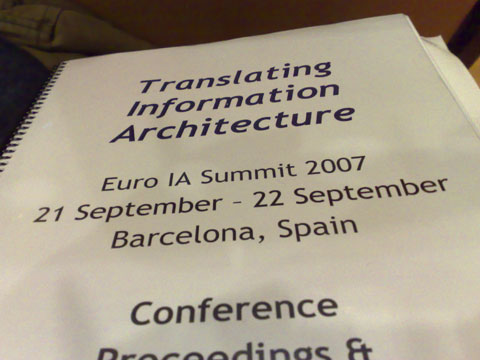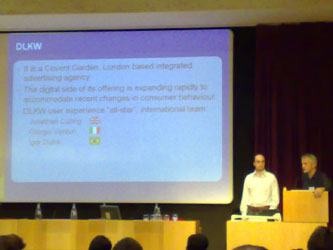Take-away facts and quotes from the Euro IA Summit in Barcelona - Day 1
Last weekend I was in Barcelona for the Euro IA Summit, and I made a solemn vow to my wife and myself that I was actually going to concentrate on doing stuff rather than spending my time and energy blogging about doing stuff.
However, it did seem rather churlish not to at the very least post my favourite take-away facts and quotes from the conference itself.

Ricardo Baeza-Yates
Ricardo is the director of Yahoo! Research Labs in Spain and Chile, and he gave the opening keynote on Friday morning. The top quotable facts I noted were:
- 50% of websites in the Chile domain are islands with no inbound links
- 30% of websites in the Spanish web are inaccessible to search engines because of Flash / frames / JavaScript etc
- Figures for looking at search results pages were 16% only looked at first few results (i.e. didn't move head) / 25% looked only at the first page (i.e. at least moved head) / 27% looked at two pages / 20% looked at 3 pages / 12% looked at more than 3 pages. I didn't spot when these figures dated from however.
- The typical Yahoo! session is a two queries of two words, looking at two answers and doing two clicks.
Bogo Vatovec
Bogo's talk - "A Nightmare Come True?" - was about a global web project involving 22 languages, business units in 15 countries, and 30,000 products, none of which were sold globally. He was very entertaining:
"I'm going to talk about a project that took five or six years of my life. Away."
"There were a couple of people who, since they did this, never wanted to have any kind of web project again"
"If you have a clueless client, use personas. No hi-tech stuff"
"One can't centralise the organisation, branding and products through the website"
Kars Alfrink
Kars delivered a fantastic session urging the IA community to "Go beyond the useful" and to incorporate things that have been learned by games designers. He wants users to enjoy their time discovering web sites, rather than being presented with dry and rigid interactions.
He cited Amazon as an example of a page whose information structure isn't rigidly designed, but which arrives as a result of rulesets governing what should be displayed to users after they have performed certain interactions. Kars said:
"I believe that in the future we will find ourselves designing these emerged solutions. You can't design this information space, you can only design the pre-conditions for this thing to take place."
He stressed that games designers had vast experience in doing just that, although it was generally viewed by outsiders as a kind of 'black magic' or 'alchemy', and it hasn't always been well-articulated by the designers themselves.
Kars wanted IA solutions that encouraged users to learn, arguing that learning to perform a skill is pleasurable, regardless of the skill in question.
"Our brains can't really discern whether we are learning something valuable"
The Q&A at the end provoked a lot of laughter. Peter Boersma asked "If you were re-designing a labyrinth, a usability expert would put a straight path all the way through to the exit, whilst an IA would probably put up signs. What would a games designer do?". Quick as a flash someone in the audience shouted out "Put a ghost in it" and then started making Pac-Man noises.
James Kalbach
James covered a lot of great ground about user-generated, technically generated and owner generated metadata and structures, but suffered from presenting just at the moment when I would normally be having my siesta. As a result, in my notes I only cherry-picked one quote.
"Within niche markets, taxonomy is still a good strategy"
The end of his session also provided evidence that the IA crowd are a lot more 'with it' and 'down with the kids' than the image of dour librarian-types conveys - the changeover music between sessions was The Arcade Fire. Although, admittedly, that may just have been down to the choice of the young technician manning the auditorium controls in the Sant Joan de Déu lecture hall where the main sessions were based.
Peter Boersma
Peter had a challenge for information architects, using real-life architecture as an example. He cited "How Buildings Learn" by Stewart Brand. He used an example from New York of measuring the performance of roofing, and extrapolating from that the best practice advice not just about the roofing, but about the business processes that produced either good or bad roofing.
Peter Boersma wants to see design pattern libraries like the one at weile.com married and augmented with process pattern libraries.
He'd like people during site build to be able to easily find out that to put bread-crumb navigation on a site they can improve it by doing card sorting, for which you need x number of people performing the tasks a, b and c.
Giorgio Venturi and Jonathan Culling
This was a case study of the redesign of BAA's Heathrow website. I got the impression that servicing the primary informational needs of the user AND satisfying BAA's need to make the site brochureware for the improved 'shopping experience' at Terminal 5 had been quite testing.

Giorgio Venturi described the site's architecture as like meeting a beautiful stranger on the street, who asked him for some information on how to get to a theatre.
"How could I satisfy her information needs, whilst trying to get to know her better and have a chance of a coffee with her"
From a more serious work point of view they had a very useful section on drawing up 'rationale' documents for key areas of the site early in the project, to ensure agency, information architect and client have agreed on why they are trying to do what they are trying to do.
Ethical Information Architecture
The final session of the day was a panel discussion about ethical Information Architecture.
There is some debate about whether the IA profession needs a code of conduct. I tend towards the view that ethical people will behave ethically anyway, and since most IAs are terribly decent and helpful folk who want to assist users at every stage of their interactions, it is probably not needed.
I have to confess however, that after a very long day's programme, once this session started running a bit late, my main ethical dilemma was judging the right moment to slink out of the auditorium and go and grab a well-deserved Spanish Catalan beer instead...
I'll cover my highlights of day two tomorrow.
Thanks for the mention and kind words Martin. Glad to hear you liked it. On the topic of the labyrinth -- adding a ghost to a labyrinth makes navigating the maze more challenging. Which in the case of a game might be a good idea. I'd say most large web sites are labyrinthine and challenging enough even without 'ghosts'. One of the arguments I tried to make was to increase the discoverability of IAs, to increase the amount of feedback and make sure it actually matters where a user has been (so the dimension of time becomes crucial).